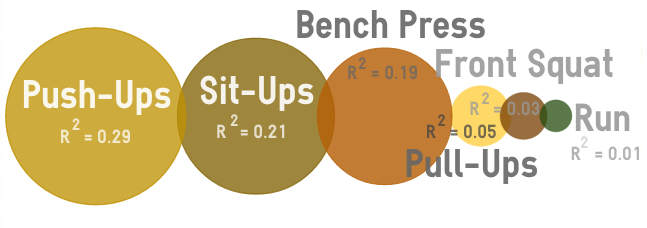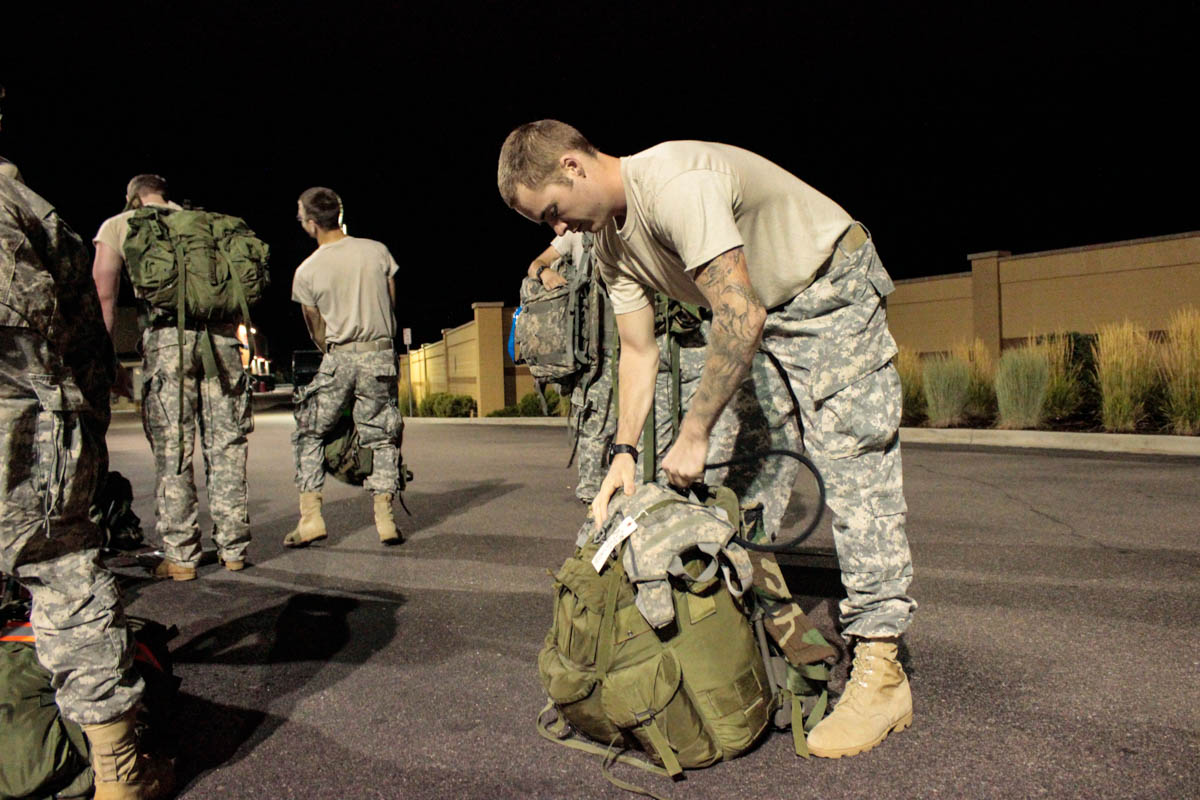By Adam Scott, MS, CSCS
Summary
In September 2015 Mountain Tactical Institute began the second official study in our Ruck Deep Dive research series. This study was designed to assess the effects of a 6-week training plan on rucking ability. Having already identified physical attributes which related to initial rucking performance (Ruck Study #1), we wanted to see how training affected these abilities, and, if possible, identify better ways to train for rucking.
In general, MTI, found that increases in strength and muscular endurance were highly correlated to rucking performance. These findings were quite different from previous research which placed an emphasis on aerobic capacity and peak VO2 measures (2,3,4,5,9). However, it is important to point out that most of the previous studies focused on much shorter ruck distances (3.2km) with much lighter loads (10-18kg).
The fact that our results differed so much from previous research could be a product of the heavier loads and longer distances we used (10km with 29kg). Or, more likely, the results are a product of the study population. The athletes in this study, particularly the males, began with noticeably low levels of strength (1RM Bench and 1RM Front Squat).
Previous research has established the importance of strength in military performance (6,7,8,11,12). A study examining Canadian Special Forces (CANSOF) applicants found that soldiers with 1RM back squats over 143.6kg (315 lbs) were 5.2 time more likely to be successful in training (6). Our male athletes averaged 198 lb bench press 1RMs and 203 lb front squat 1RMs at the start of the study. These strength measures are likely well below optimal levels for rucking.
On the other hand, one estimate of male participant VO2max scores (based on 2-mile times) placed them around 45 ml/kg/min. While this is also below the 55 ml/kg/min which was found in the CANSOF study, it is proportionally higher than their strength scores. Thus, our athlete’s low strength was likely preventing them from maximizing their aerobic contribution to rucking. This is one possible reason why improvements in strength, particularly upper body strength, contributed the most to rucking improvement.
Another interesting finding was that high performing athletes and/or those who excelled in at least one physical area (endurance, strength, etc.) produced “noisy” results. When looking at data from these athletes it was difficult to identify specific individual training factors because their superior abilities in one or more areas allows them to compensate for deficiencies on other areas – i.e. masking individual training effects.
In the end, the results from this study appear to hint at an underlying “base-strength requirement” for moving under load. That is to say, an athlete needs to, at the least, have a minimum level of upper and lower body strength in order to maximize their load carriage potential. Until this level is reached, improvements in strength and muscular endurance are the most important training factors. However, after reaching these levels, other factors become increasingly important to improving performances.
Unfortunately, the strength differentiations we used in this study were relatively low – as we were limited by the ability of our subjects. For our purposes “high” and “low” strength levels were divided at 185# for both front squat and bench press. It is likely that, had the study used more subjects or subjects with higher relative strength scores, we might have been able to more accurately estimate this theoretical standard.
Future research should closely examine each individual training factor in order to determine how they relate to an athlete’s ability to improve ruck performance. In the meantime, the following recommendations are offered based on our current findings.
Recommendations for Female Athletes:
- When it comes to improving rucking performance females should likely first focus on increasing lower body strength (i.e. front squat).
- Improvements in core strength and unloaded running (aerobic capacity) also have a very strong and strong, respective, relationship to female rucking improvements. These two factors should be secondary focuses for females looking to improve their rucking ability.
FIGURE 1: Coefficients of Determination for Female Athletes
Circle Size Indicates Effect Size
Recommendations for our Male Athletes:
- Improvements in strength and endurance can “make-up” for deficiencies in height and weight – which we found to be highly predictive of rucking performance in Ruck Study #1.
- Assuming athletes are starting at a similar, low-strength level like our subjects (~ 195# 1RM Front Squat and 1RM Bench Press), males should first train to increase upper body muscular endurance and core strength.
- If an athlete has a sufficient level of strength (which, unfortunately, is still TBD), then aerobic training should be the focus – as this will be the most beneficial determinant of rucking improvement (2,3,4,5,9).
FIGURE 2: Coefficients of Determination for Male Athletes
Circle Size Indicates Effect Size (note the much smaller effects when compared to females)

- Also, based on an athlete’s current fitness level and ability, individualized training recommendations can offer more specific means of improvement. For example, this study found that:
- Lighter Athletes (<170#) will likely see significant improvements in rucking from strength gains (upper and lower body)
- Faster Runners (2mile <14:00) will likely benefit the most from building upper body muscular endurance.
- Faster Ruckers (10km @ 29kg <90mins) should probably focus their training on lower body strength and upper body muscular endurance.
Study Details: See Full Study- Ruck Deep Dive – Study 2
References:
- Headquarters Department of the Army. U.S. Army Field Manual 18-21. Washington, DC, 01 JUNE 1990.
- Harman, E., Gutekunst, D., Fryman, P., Nindi, B., Alemany, J., Mello, R. and Sharp, M. Effects of Two Different Eight-Week Training Programs on Military Physical Performance. J Strength Cond. Res. 22(2): 524-534, 2008.
- Dziados, J., Damokosh, A., Mello, R. and Vogel, J. Physiological Determinants of Load Bearing Capacity. US Army Technical Report No. T19/87. US Army Research Institute of Environmental Medicine. 1987.
- (4) Knappick, J., Harman, E., Steelman, R., and Graham, B. A systematic review of t he effects of physical training on load carriage performance. J Strength Cond. Res. 26(2): 85-597 2012.
- Swain, D., Ringleb, S., Naik, D. and Butowicz. Effect of traning with and without a load on military fitness tests and marksmanship. J Strength Cond. Res. 25(7): 1857-1865 2011.
- Carlson, M.J. and Janen, S.P. The Development of a Preselection Physical Fitness Training Program for Canadian Special Operations Regiment Applicants. J Strength Cond. Res. 26(7):S2-S14, 2012.
- Abel, M.G., Plamer, T.G. and Trubee, N. Exercise Program Design for Structural Firefighters. Strength and Cond. J. 37(4):8-19, 2015.
- Orr, R.M. and Pope, R. Optimizing the Physical Training of Military Trainees. Strength and Cond. J. 37(4):53-59, 2015.
- Connolly, M., Elder, C. and Dawes, J. Needs Analysis for Mountain Search and Rescue. Strength and Cond. J. 37(4):35-42, 2015.
- Global Security. Available at http://www.globalsecurity.org/military/systems/ground/interceptor.htm. Accessed October 28, 2015.
- Knappik, J.J. and Gerber, J. Influence of physical fitness training on the manual material handling capability and road marching performance of female soldiers. Aberdeen Proving Ground, MD. Human Research and Engineering Directorate. U.S. Army Research Laboratory Technical Report No. ARL-TR-1064, 1996.
- Knappick, J.J., Sharp, M.A., Darakjy, S., Jones, S.B., Hauret, K.G. and Jones, B.H. Temporal changes in the physical fitness of United States Army recruits. Sports Med 36:613-634, 2006.
- Brown, P.E.H., Fallowfield., J.L., Blackard, S.D., Izard, R.M., Wilkerson, D.M. and Bilzon, J.L.J. Physical and physiological adaptations to British Army Infantry Recruit Training. Med. Sci. Sports Exerc. 40:S159, 2008.
- Harman, E.A., Frykman, P., Palmer, C., Lammi, E., Reynolds, K. and Backus, V. Effects of a specifically designed physical conditioning program on the load carriage and lifting performance of female soldiers. Natick, MA: U.S. Army Research Institute of Environmental Medicine. Technical Report No. T98-1, 1997.
- Williams, A.G., Rayson, M.P. and Jones, D.A. Effects of basic training on material handling ability and physical fitness in British Army recruits. Ergonomics 42:1114-1124, 1999.
You Might Also Like MTI’s Rucking Improvement Plan

